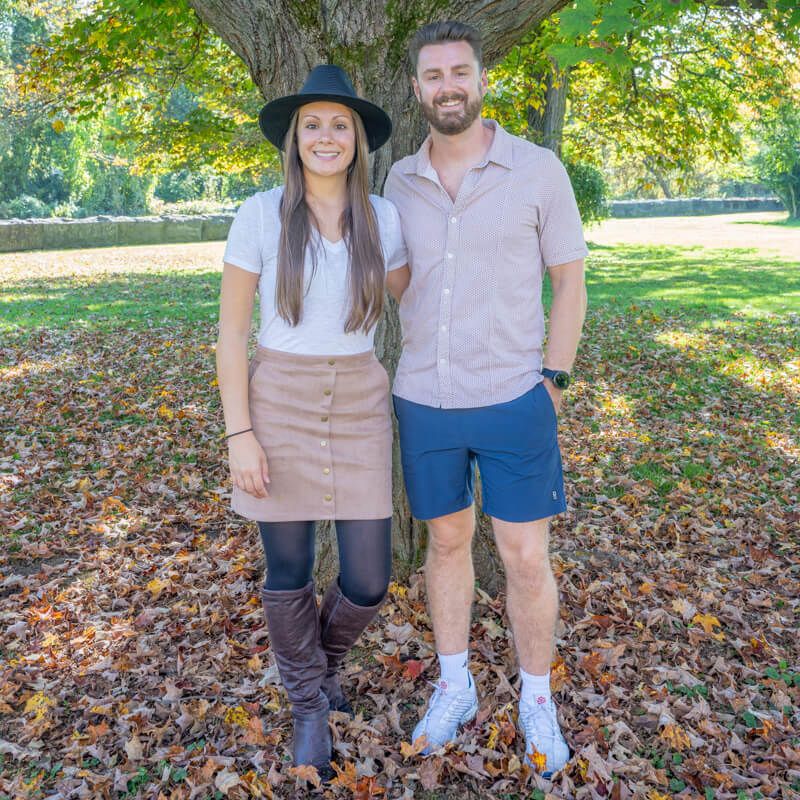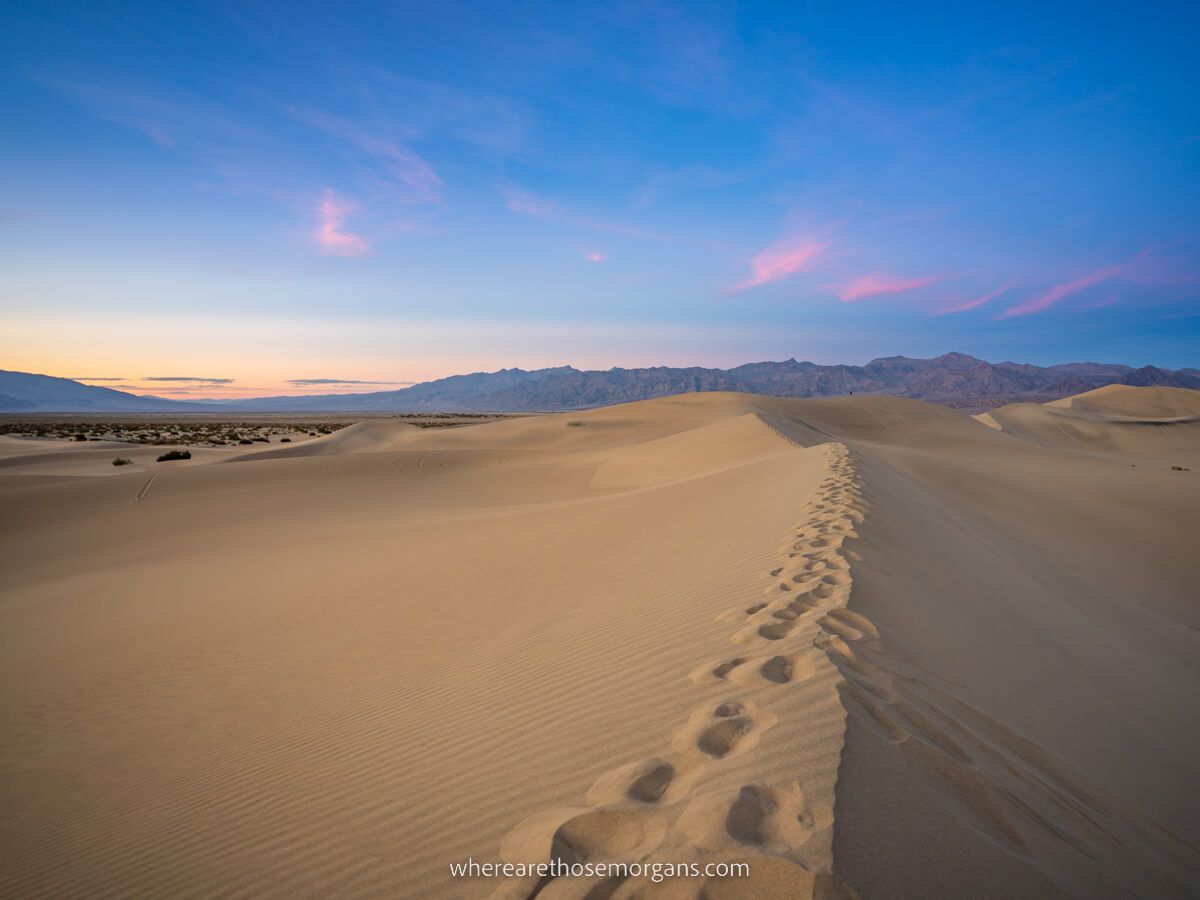If you visit Death Valley National Park in winter you can expect cool temperatures, fewer crowds, more lodging availability and snow capped peaks. We’ve visited Death Valley in December and we think it’s a great time of year for you to visit if you want to avoid overcrowding and save money, as long as you don’t mind cold mornings and shorter daylight hours.
In this guide we walk you through the 10 most important things you should know about visiting Death Valley National Park in December based on our experiences.
Our Experience
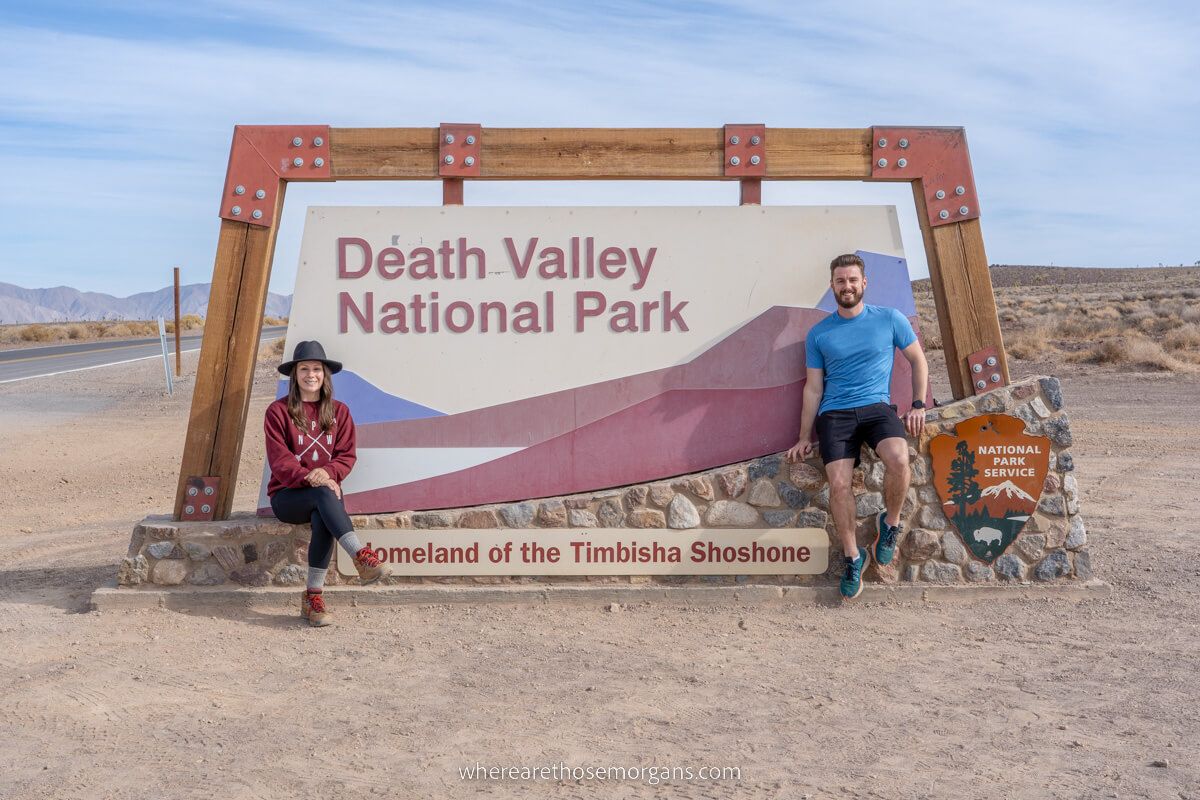
We first visited Death Valley for 3 days in October 2019, and then we went back for another 3 days in December 2021. It’s one of our favorite US national parks because it’s incredibly unique, vast and photogenic. We love hiking and photographing diverse landscapes and this hostile but beautiful environment has it all.
What we liked most about visiting Death Valley in winter was how quiet it was at hikes, photo spots, viewpoints and attractions. Sure, we’ve run into a few incidents in the park (which we’ll explain later), but it’s one of the hottest places on Earth, so incidents are par for the course! Read more about us.
1. Crowds
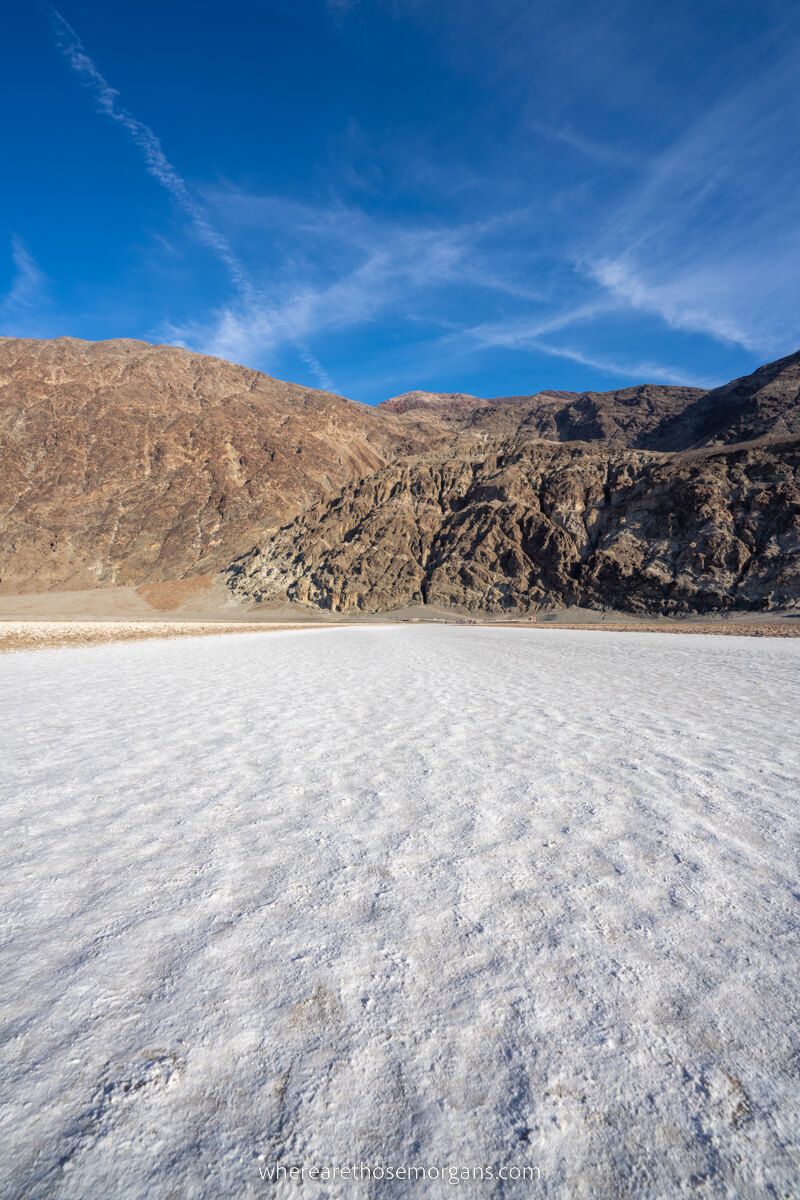
Death Valley is a popular national park but it doesn’t get the same volume of tourists as the likes of Zion, Grand Canyon or the Great Smoky Mountains. And at 3.4 million acres, it’s the largest national park in the lower 48, so even when it’s busy, it never suffers from the same serious overcrowding issues. Even better news for your visit is that December is the least crowded month of the year in Death Valley.
Our experience: Even though fall is also a quieter time to visit the park, we still noticed a difference in crowd numbers between October and December. We never had any issues getting parked anywhere, we had places like Badwater Basin and Mesquite Sand Dunes almost entirely to ourselves, and we barely saw other hikers on the popular trails.
How Does Fewer Visitors Benefit You?
- More availability at hotels
- Cheaper prices at hotels
- Parking lots at popular spots won’t fill
- Cool temperatures are better for hiking
- Hiking trails will be quiet
- Easier to get photos
We think December represents the perfect time for you to visit Death Valley if your top priority is to avoid crowds. There’s lots of great benefits and the trade-off is minimal.
2. Weather
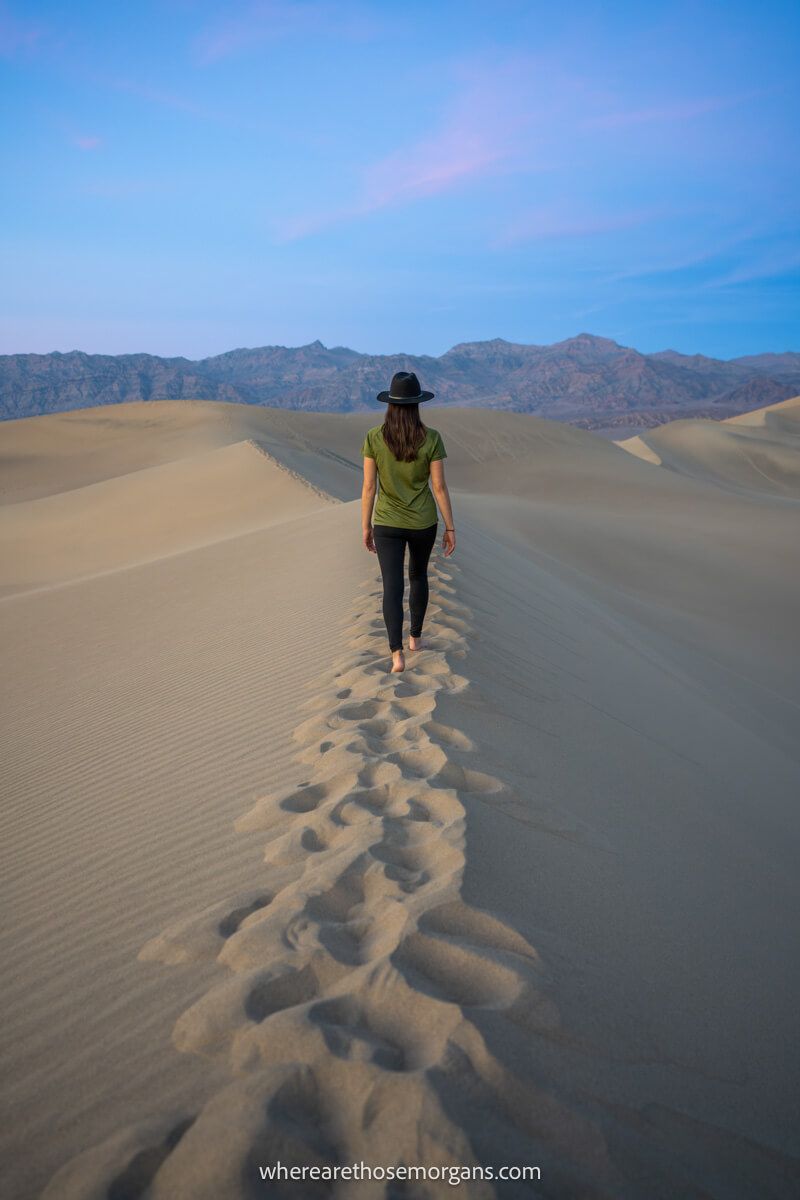
December is the coldest month of the year in Death Valley National Park; it’s when average highs and lows are the coolest they’ll be all year. But considering how oppressively hot it can be in spring, summer and fall, we honestly think winter is the most comfortable time of year to visit Death Valley. It also marks the beginning of the park’s stormy season, but they’re very rare.
Our experience: We noticed a huge difference in temperature between our October and December visits to Death Valley. In October we were struggling with heat on hikes and even at night it felt like we were trapped in a sauna. Whereas, we found mornings and evenings to be slightly on the chilly side in December, but we were mostly hiking in shorts and t-shirts during the day. Personally we prefer cooler temperatures and fewer crowds every time, how about you?
Death Valley December Weather Statistics
- Average high – 65°F (18°C)
- Average low – 38°F (3°C)
- Average temperature – 51°F (10°C)
- Record high – 89°F (32°C)
- Record low – 19°F (-7°C)
- Average precipitation – 0.19 in
Source: NPS
More weather features you might be interested in:
- Fourth highest amount of precipitation (still very low)
- Highest humidity of the year (around 41%)
- Least amount of sunshine (just over 7 hours per day)
Source: Weather US
3. Daylight Hours
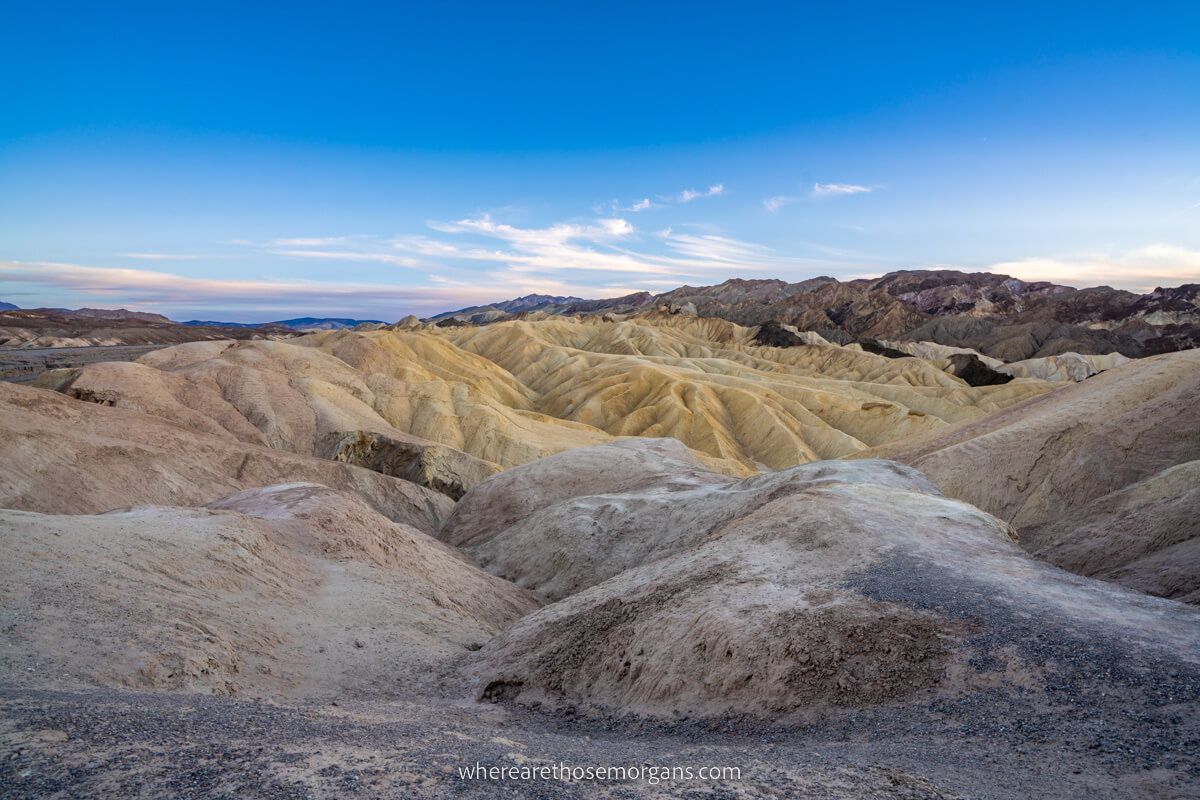
One of the rare negative aspects to visiting Death Valley in December is shorter days and fewer daylight hours. There’s not a single day in the month with over 10 hours daylight, and on December 21st (winter solstice) you’d only get 9 hours and 40 minutes daylight. Plus, the clocks go back for daylight savings in November, so sunset is around 4:30pm every day in December. Check sunrise and sunset times here.
Our experience: We must admit the early sunset time was challenging during our visit. We had to get really early starts and be out in the car by 6:30am so we could make the most of the day, and then be at sunset spots like Zabriskie Point by 4:00pm latest. But the good thing about early sunsets is getting to dinner at a reasonable hour!
How Will Shorter Days Impact Your Visit?
In essence, the shorter days will result in you having less time to see and do the best things in Death Valley. There are very few things you can do at night in unless you’re interested in astrophotography, so the key is to start as early as you can manage and get a head start on the daylight. We were caught out a few times on hikes with darkness creeping in by 3:30pm, so it’s important to carry headlamps in your daypack.
And by starting early you’ll also get the beat on any day trippers arriving into the park, so a bit of advice from us is to go to whatever’s at the top of your bucket list early in the morning. The final reason it’s great to start early is because you can hike any trails before it gets too hot around lunch time. You might have guessed that getting an early start is our top recommendation!
4. Lodging
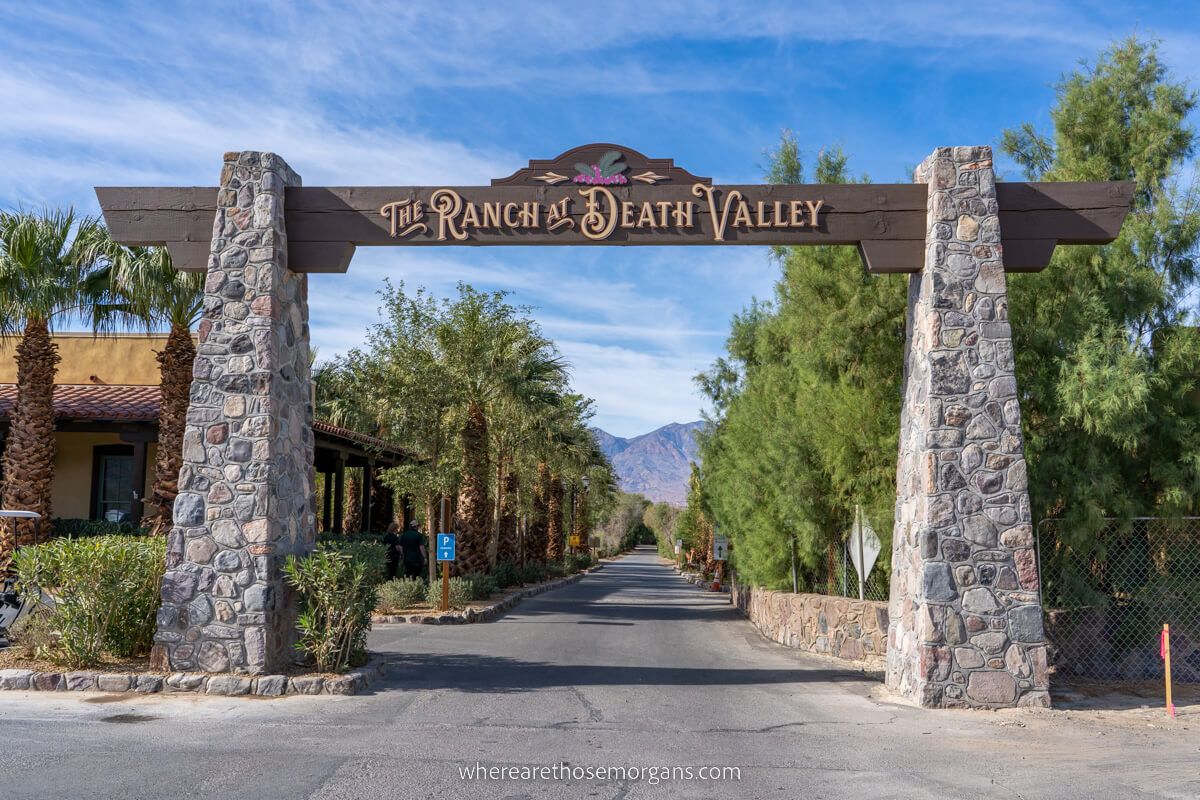
Getting back to big positives, you’d benefit enormously from lower occupancy rates and cheaper prices at hotels near Death Valley if you visited in December. We think lodging inside the park is excessively expensive year round for what you get; you’re basically paying for the convenience of being close to attractions. But you can also stay at a number of small towns around the park boundaries, and that’s where you’ll save the most in winter.
Our experience: After two trips to the park, we can confidently say that figuring out places to stay is the most difficult part of itinerary planning. Death Valley is gigantic and its attractions are spread out so it makes sense to move hotels each night, unless you stay at one of the two super-expensive hotels in Furnace Creek. But we refuse to pay those prices, so we’ve stayed in Lone Pine, Beatty, Furnace Creek (camping) and Pahrump for a total of 6 nights.
Where To Stay
IN THE PARK: If you don’t mind paying over the odds prices, you should stay at The Inn At Death Valley or The Ranch At Death Valley because they’re centrally located between all of Death Valley’s top attractions. Alternatively, you can stay at Stovepipe Wells or Panamint Springs which are cheaper and still inside the park, but they’re further from most attractions.
- Furnace Creek – The Inn at Death Valley
- Furnace Creek – The Ranch at Death Valley
- Stovepipe Wells – Stovepipe Wells Hotel
- Panamint Springs – Panamint Springs Motel
CAMPING: If you want to stay centrally in Furnace Creek but you’re visiting on a super-low budget, you can camp or park an RV at one of three campgrounds: Sunset, Texas Springs or Furnace Creek.
Exclusive: Our readers can take advantage of our exclusive no-strings 30-day free trial with The Dyrt Pro to get notifications when fully booked campsites have cancellations.
NEARBY: Finally, you can stay in towns like Beatty, Lone Pine or Shoshone which are all located close to the park’s attractions. You’ll get cheaper rates and more amenities like restaurants and laundry.
Our recommendations:
- Beatty – Death Valley Inn
- Shoshone – Shoshone Inn
- Lone Pine – Dow Villa Motel
Whether you stay inside or outside the park, what we do know for sure is that you’ll get cheaper rates in winter when compared to any other season.
READ: Where to stay around Death Valley
5. Hiking
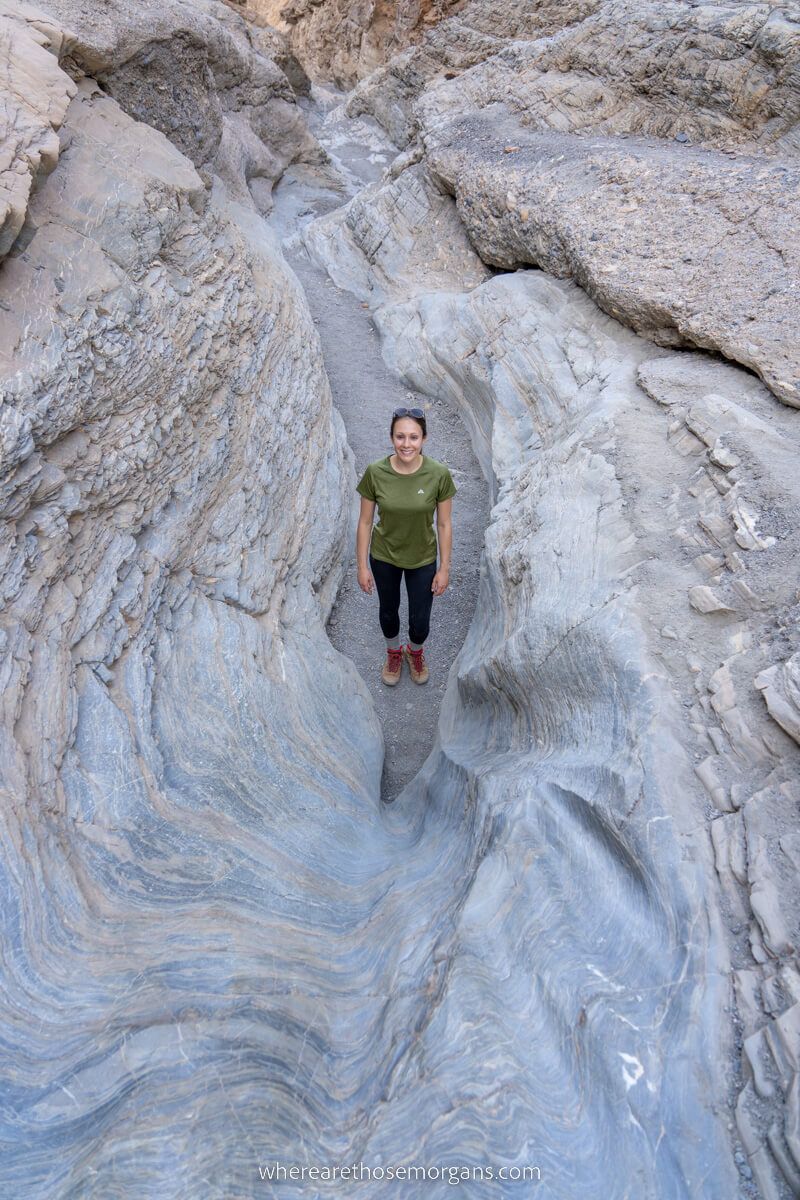
Death Valley’s most popular trails are all located in its lowest altitudes at the bottom of the valley, so December is a perfect time to hike in comfortable conditions. But you won’t be able to hike any of the higher altitude trails unless you have serious equipment and lots of experience. Remember about the lack of daylight and earlier sunsets if you start a hike after lunch.
Our experience: We definitely preferred hiking in December than in October because the temperatures were much cooler and the trails were much quieter. It’s a win-win. We ended up hiking the full Golden Canyon Trail, Mosaic Canyon, Mesquite Sand Dunes, and Desolation Canyon during our winter visit.
Recommended Hikes
- Golden Canyon
- Mosaic Canyon
- Desolation Canyon
- Natural Bridge
- Mesquite Flat Sand Dunes
- Salt Creek Interpretive Trail
- Sidewinder Canyon
- Darwin Falls
6. Photography
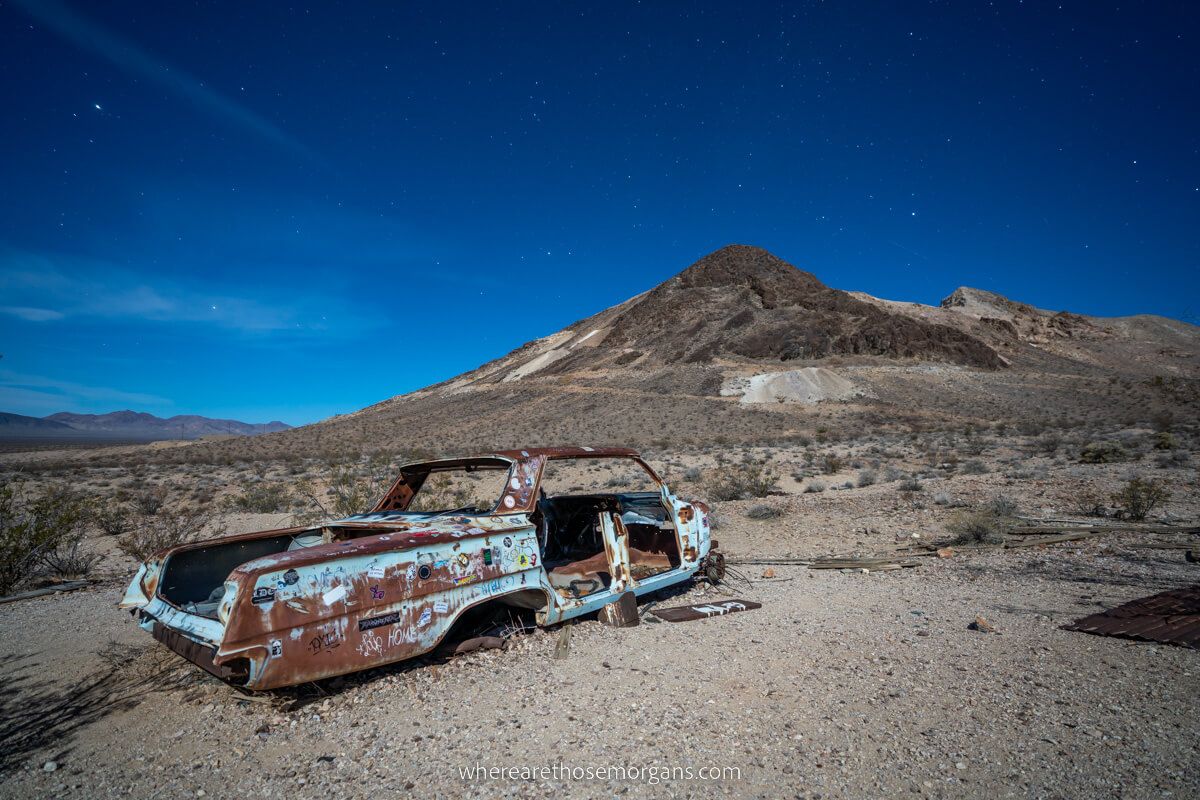
Death Valley is a fantastic place for beginner and professional photographers to challenge themselves in a unique environment filled with unspoiled nature. And because it’s so quiet in December, you get a lost world feel, as though you’re going to be the first person to ever take a photo at a certain location in the park.
Here’s what makes winter great for photography:
- Storms are more common
- Earlier sunrises mean fewer people will be out
- Earlier sunsets mean you can get out to dinner early
- Lower angled sunlight creates deeper canyon contrasts
- Cooler temperatures mean you can stay out all day
- Soft light at golden hours
- Fewer tourists getting in your backgrounds
Our experience: We’re travel photographers, and we think Death Valley is a hugely underrated landscape within the US national park system. Yes, it’s barren and bleak, but if you look hard enough, it’s also raw and strikingly beautiful. We enjoyed photography on hikes, drives, sand dunes, viewpoints and even at night in the ghost town.
Recommended Photo Spots
- Rhyolite Ghost Town
- Titus Canyon
- The Racetrack
- Ubuhebe Crater
- Mesquite Sand Dunes
- Badwater Basin
- Zabriskie Point
- Dante’s View
7. The Food Scene
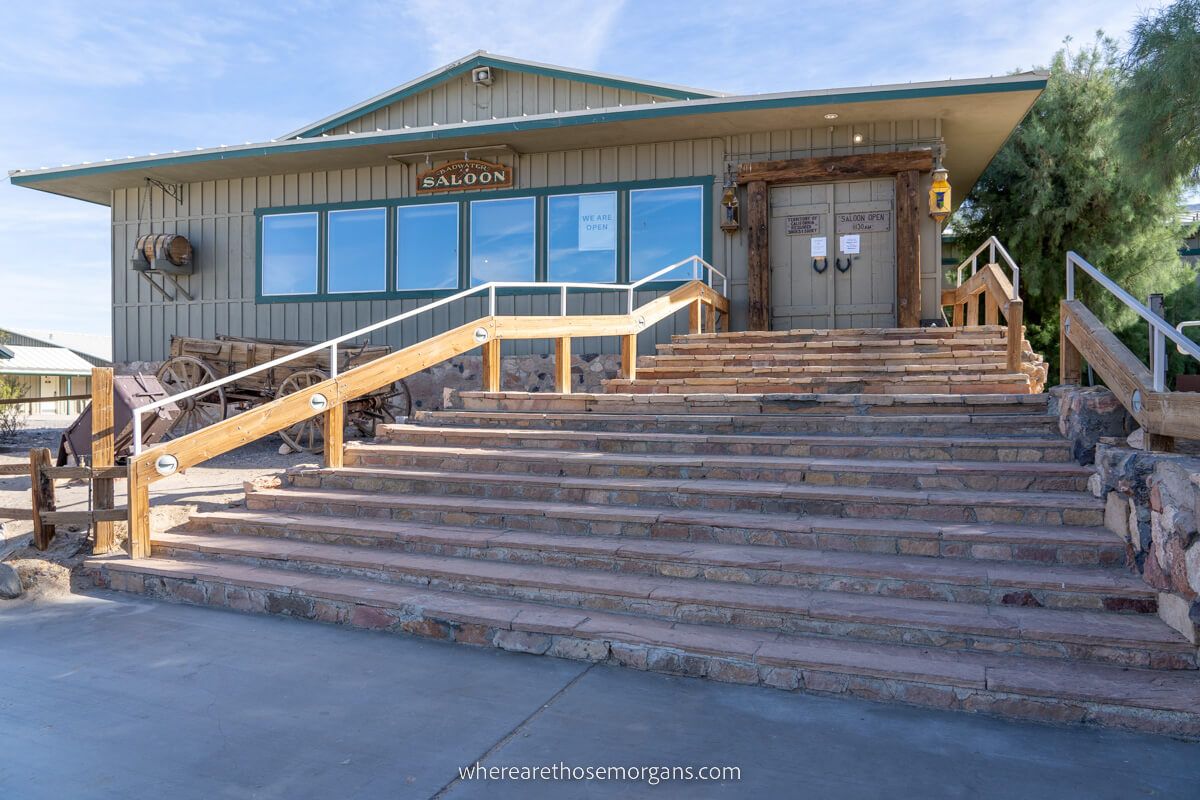
Death Valley’s food scene is the same in December as it is the rest of the year, not great. In fact, we’d go as far as saying the facilities overall could do with some improvement, or at least more options becoming available inside the park (especially in Furnace Creek). If you’re camping, staying in an RV or bringing along a cooler, we recommend you stock up with lots of food and drinks.
Our experience: Inside the park we’ve only eaten at Stovepipe Wells restaurant and it was good, so we recommend you eat there or in Panamint Springs if you can. Outside the park we’ve eaten Chinese food in Lone Pine, barbecue in Beatty and pizza in Pahrump, and they were all fantastic. During the days we ate pre-packed sandwiches and wraps from our cooler.
Where To Eat
IN THE PARK: The Inn and Ranch hotels in Furnace Creek have decent food, but they’re very expensive and you have no other choices. Stovepipe Wells has the top rated eateries in Death Valley, with a bar and restaurant serving up good quality food at more reasonable prices. Panamint Springs also has a good place to eat with a huge selection of beers available.
- Furnace Creek – The Inn At Death Valley Dining Room
- Furnace Creek – Last Kind Words Saloon
- Stovepipe Wells – Toll Road
- Panamint Springs – Panamint Springs Restaurant
Note: The problem with Stovepipe and Panamint is that unless you’re staying there, or you’re on your way in or out of the park to the west, they’re quite a way out from the major tourist area around Furnace Creek. There are general stores in Furnace Creek, Stovepipe Wells and Panamint Springs with snacks, drinks and light groceries but they’re mostly designed for people staying in campgrounds.
OUTSIDE: You’ll have more dining options if you stay in a town near the park, plus you can buy cheaper and better food in the morning to use as a packed lunch when you’re in the park.
- Lone Pine – Seasons Restaurant
- Lone Pine – Merry Go Round
- Beatty – Smokin’ J’s Barbecue
- Beatty – Mel’s Diner
- Shoshone – Crowbar Cafe Saloon
- Pahrump – Farinata Pizza
8. Safety
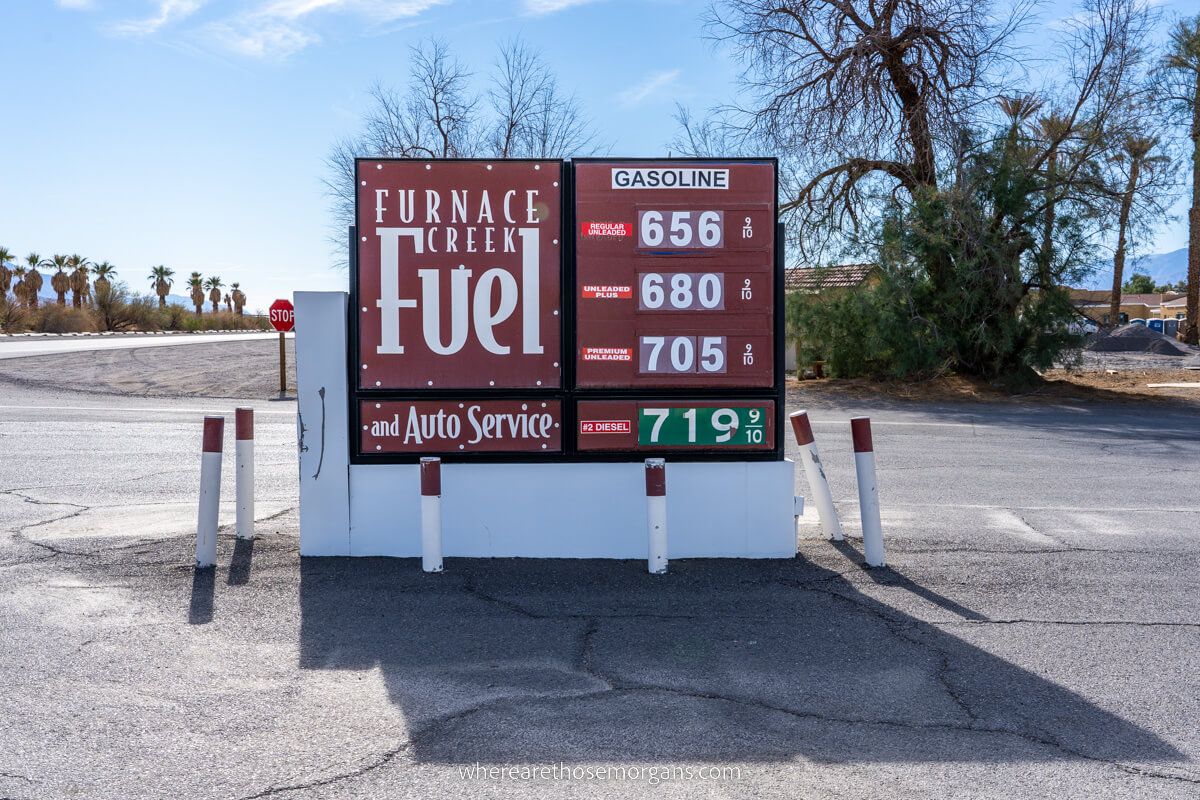
Your safety is the most important topic we cover in this guide. Death Valley is a harsh and hostile environment no matter when you visit. It’s enormous, isolated, barren, mountainous and extreme. Plus, cell service is limited in most areas, so you really don’t want to get stuck in the middle of Death Valley-nowhere an hour before sunset because you forgot to top up your oil!
Our experience: So far in Death Valley we’ve had a sandstorm tear through the campground at 4:00am (we almost lost our tent and had to sleep in the car), our SUV has overheated because there’s no shade anywhere and we’ve had sunburn despite putting on lots of sunscreen. And remember this is in October and December, not May-September.
What You Should Consider
CAR: Get your car properly checked out before you visit Death Valley. Top up all your fluids, make sure all your tires are in good shape and carry spares. You should also have emergency gear in your trunk in case you breakdown.
GAS: There are three gas stations in the park at Furnace Creek, Stovepipe Wells and Panamint Springs. But it’s important to know they often have unexpected opening hours and the prices are astronomical. We’re talking over $7/gallon at Furnace Creek. If you must fill up in the park, do it at Stovepipe Wells because gas is cheaper. Otherwise, fill up before you enter each day.
HEAT: Sure, temperatures aren’t going to be 120F like in summer, but you’ll find the days still get hot in winter because the valley traps heat between the mountains. We found ourselves guzzling water and feeling heat-fatigued on hikes.
WATER: It really is critical that you carry more water than you think you need. Take a few gallons in containers and leave them in your trunk, then simply top up your water bottle to carry around on hikes. You could be miles and miles away from civilization and have problems with your car, so you must have water.
9. Packing
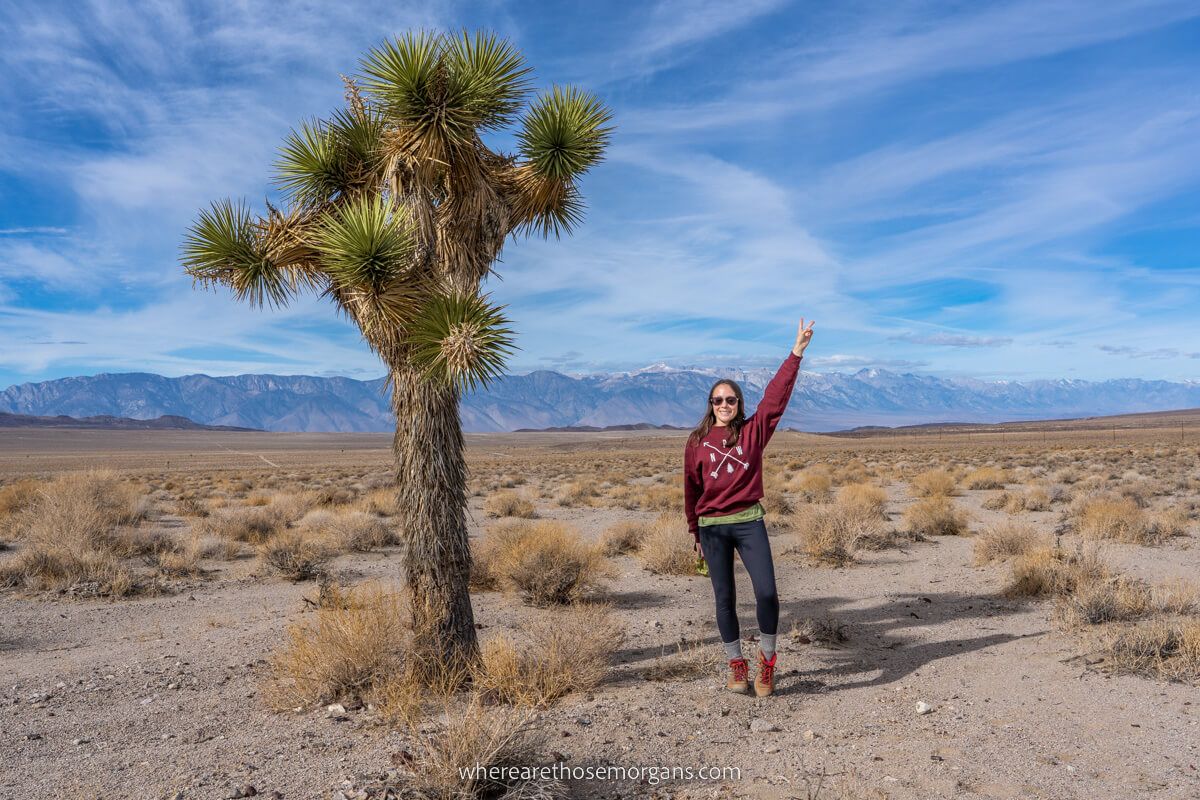
Packing for Death Valley in winter is fairly straightforward, just treat it like you’re going to any of the popular northern US national parks in spring or fall. You won’t need any specialist gear or equipment unless you plan to take on hikes like Telescope Peak, but you will need layers, and lots of them.
Here’s what you’ll experience throughout the day:
- Chilly early morning
- Cool mid-morning
- Hot between lunch-afternoon
- Cool early evening
- Chilly nights
Our experience: We were driving from Seattle to Sedona late in the year so we had lots of clothes and shoes with us in Death Valley. Mark spent most of the time in shorts, t-shirts and hiking shoes, whereas Kristen wore light hiking pants with t-shirts to hike and a middle layer sweater for in-between. But we both put our coats on for astrophotography at night!
Basic Essentials List
- Underwear and normal socks
- Hiking socks (we use Darn Tough)
- Shorts or light long pants for hiking
- Moisture wicking t-shirts for hiking
- Medium layers to pack on hikes
- Casual gear for evenings
- Sunglasses, sunscreen and baseball cap
- Medium coat, gloves and hat for nights
- 2 pairs of shoes for hiking and evenings
- Camera, lenses, tripod and plenty of data storage
10. Things To Do
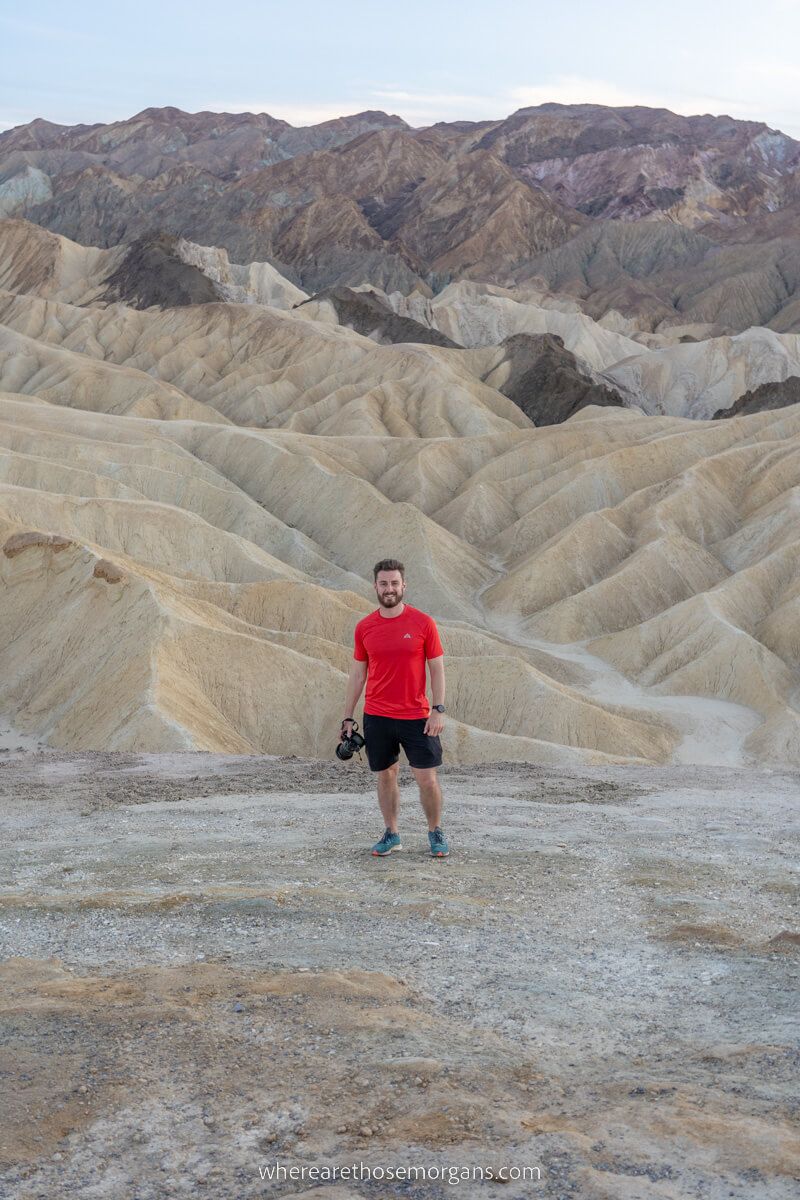
The beauty of visiting Death Valley in winter is that you can do the same things as you could any other time of year, but with fewer people around, cooler temperatures and cheaper hotels. Usually there’d be a trade-off with activities, but not here. Hiking, photography, driving 4WD roads and visiting unique attractions are the best things to do in Death Valley in December.
Our experience: We hiked awesome canyon trails, watched sunset at Zabriskie Point and Mesquite Sand Dunes, photographed Ryholite at night and walked alone on Badwater Basin in December. During our previous trip in October we also drove Titus Canyon 4WD road which was incredible, but we only recommended it for high-clearance vehicles.
Recommended Activities
- Hike canyon trails
- Photograph the landscape
- Sunrise at Zabriskie Point
- Sunset at Mesquite Sand Dunes
- See Artist’s Palette
- Drive Titus Canyon
- Rhyolite Ghost Town at night
- Climb Ubuhebe Crater
- Visit The Racetrack
The Morgan Conclusion
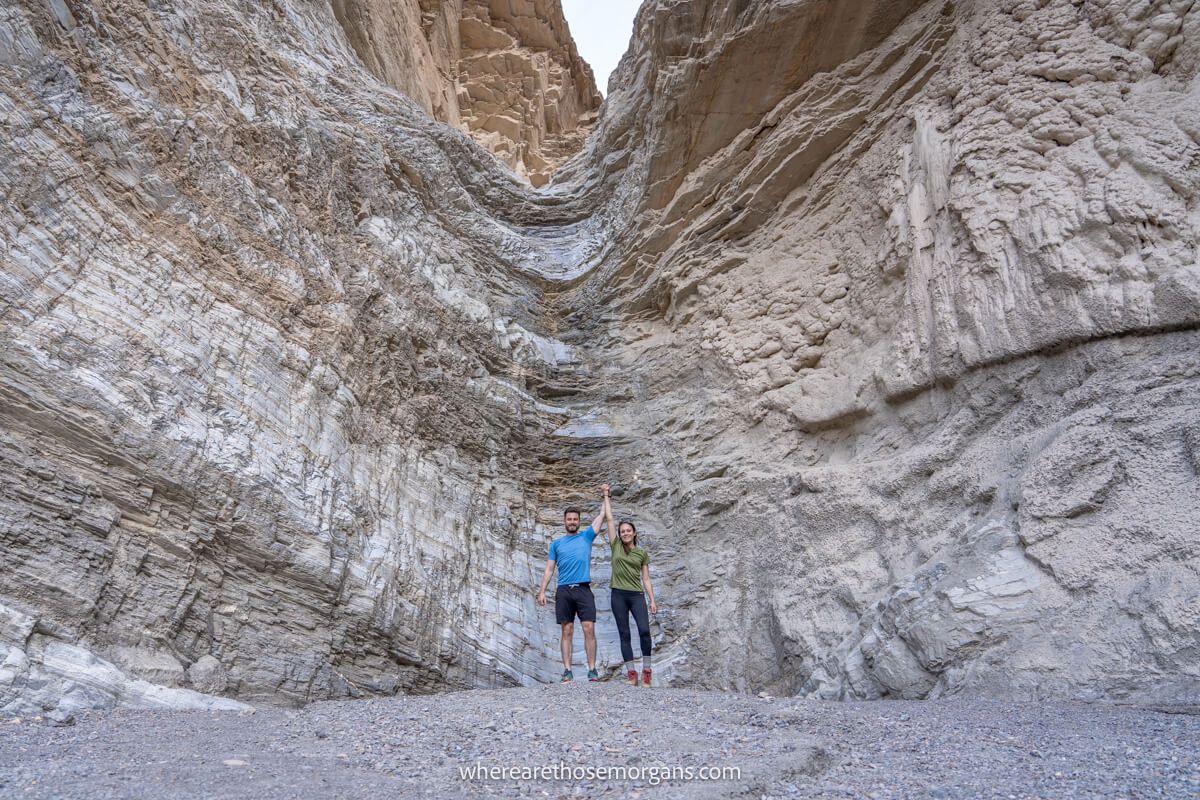
Death Valley is a unique landscape that’s busiest in spring, summer and fall despite temperatures being dangerously high. Personally, we think December is the best month of the year to visit because it’s quieter, cheaper, safer and better for hiking.
Unless we wanted to climb to the high peaks, we would choose December again the next time we visit Death Valley, so we could take advantage of the perks without sacrificing on attractions. The only real downside is fewer daylight hours, but that’s something we can work around. Can you?
More Seasonal Guides
- Acadia National Park in the fall
- Grand Canyon in winter
- Lake Tahoe in November
- Las Vegas in November
- New York City in April
- New York City in winter
- Sedona in December
- Yellowstone in April
- Yellowstone in October
- Yosemite in October
- Zion National Park in winter
Want more California content? Head to our California Travel Guides to explore National Parks, popular road trips and things to do in major cities of the sunshine state.
We hope this guide to visiting Death Valley in December helps with planning your trip to California!
Please let us know if you have any questions in the comments below.
Happy Travels,
Mark and Kristen
Enjoy this guide? Pin it for later!
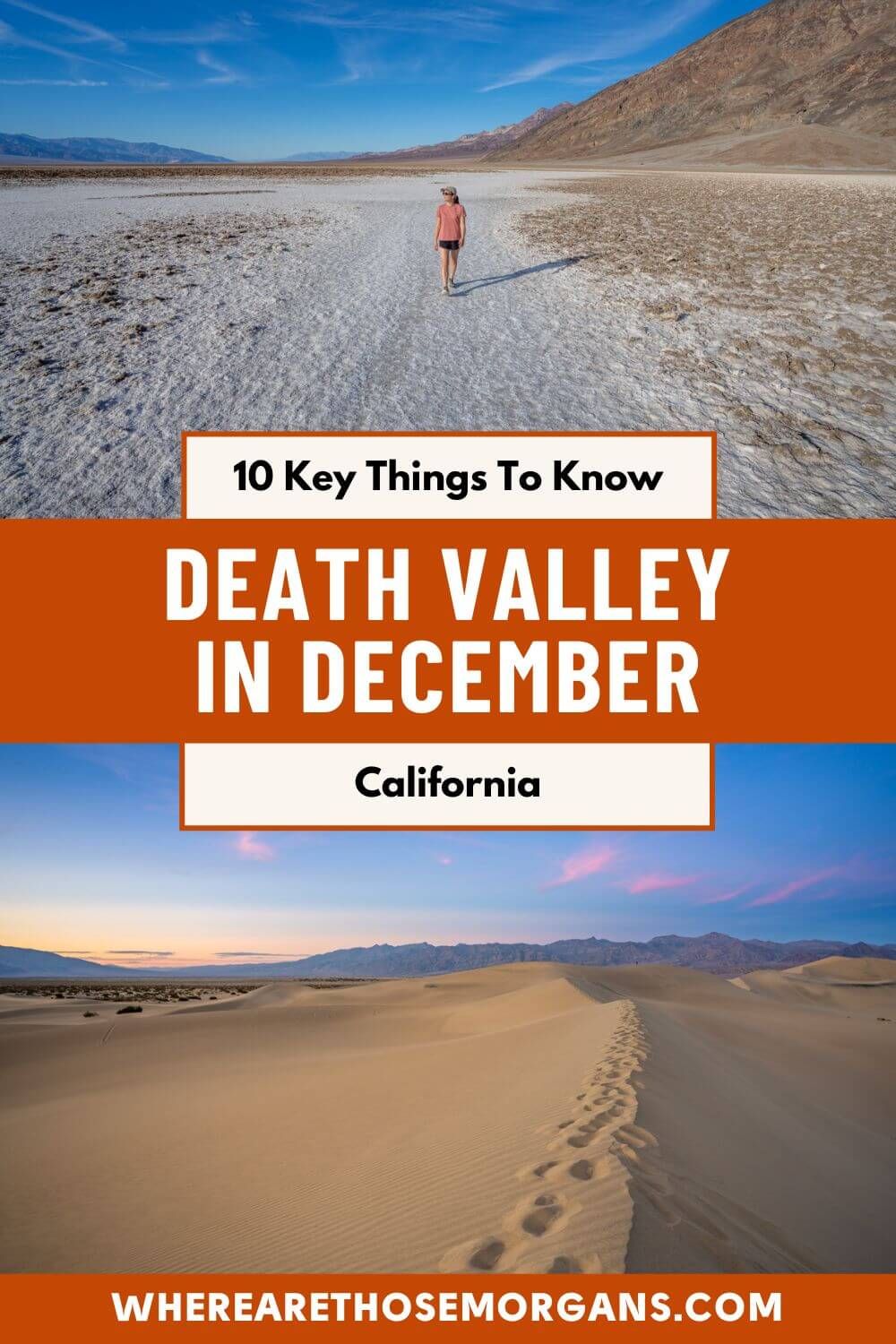
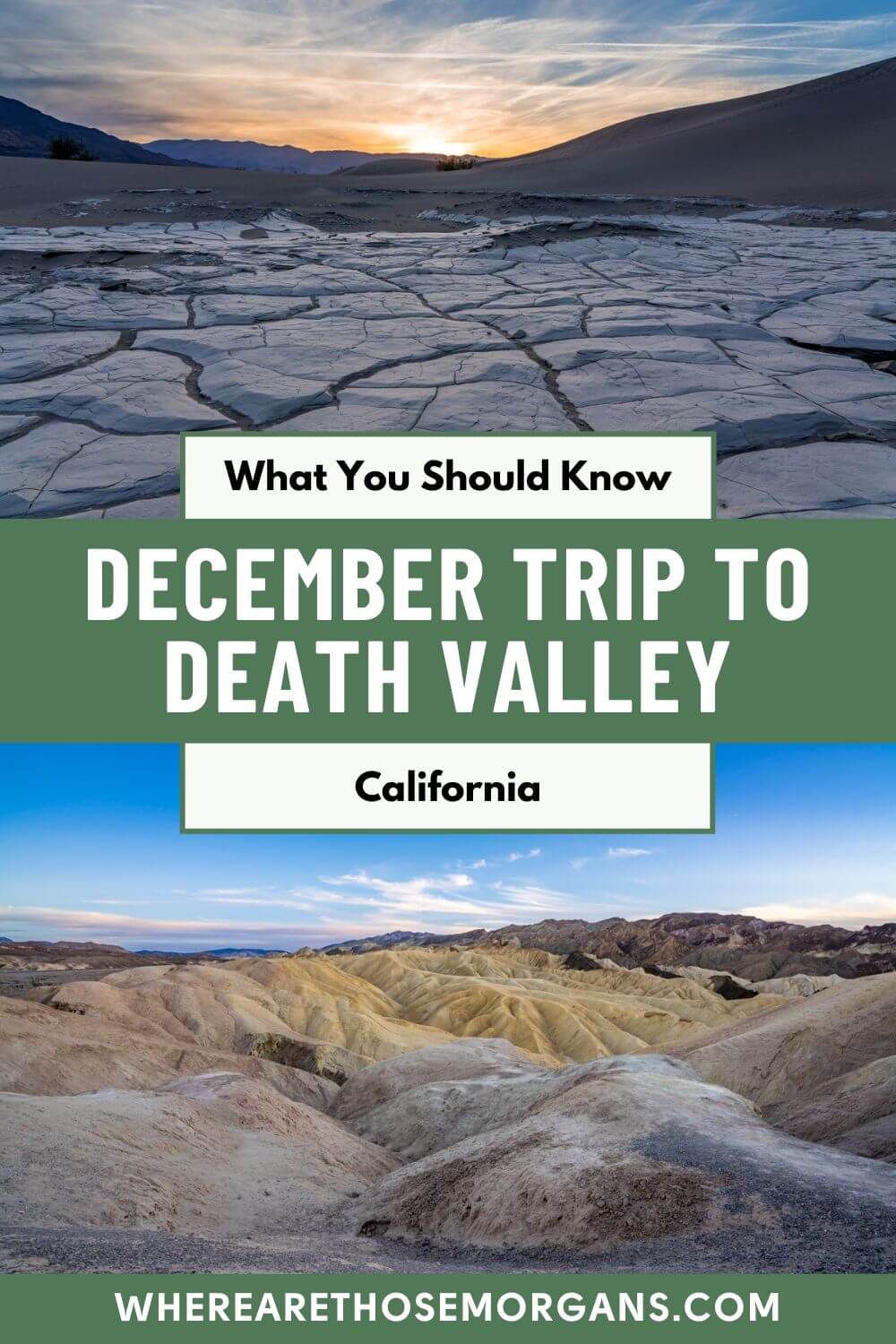
Note: This article contains affiliate links. When you make a purchase using one of these affiliate links, we may earn a small commission at no extra cost to you.
All Rights Reserved © Where Are Those Morgans, LLC. Republishing this article and/or any of its contents (text, photography, maps, graphics, etc.) in whole or in part is strictly prohibited.
Mark and Kristen Morgan are travel, hiking and photography experts. Over the last 6 years traveling full time, they have explored more than 40 countries and 30 US states.
Where Are Those Morgans has been featured in USA Today, Gestalten, Get Your Guide, CityPASS and Condé Nast Traveler along with various other publications. Read more about us.

